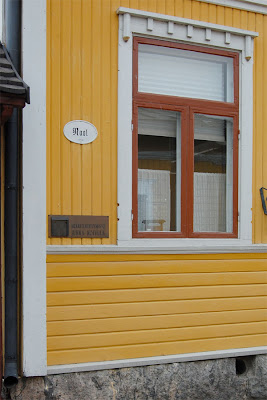Some good things that I have eaten recently:
In Tampere, at
Plevna in the old Finlayson textile mill, I had mustamakkara, "black sausage," accompanied by the brewery's own cider. Mustamakkara is the traditional sausage of Tampere; it is made from cow's blood and served with lingonberry jam. The only other time I've eaten blood sausage was at
Les Trois Soleils du Montal in the Périgord. The Tamperelainen version had a looser consistency and, while quite flavorful, and was not quite as strong.
Suomenlinna has at least two good places to eat. The
Walhalla pizzeria occupies part of a fortified building at the south end of Kustaanmiekka. Finnish pizza is not always good, but the ones here are excellent, even if the toppings are unfamiliar to American palates. My "Nikolai" pizza (named for Nikolai Sinebrychoff, whose brewery is now an art museum) included capers, pickles, and sour cream! At the north end of Iso Mustasaari, just off the main ferry quay, the
brewery restaurant offers surprisingly good food at reasonable prices. I've eaten here twice and have been impressed both times.
Probably the best meal I've had since coming here was at
Nokka. The restaurant is on Kataja
nokka, of course, in a brick building just under Uspenskin cathedral. It's hard to know whether the best seats look north over the harbor or are next to the floor-to-ceiling window to the kitchen. (The kitchen is immaculate, but it was odd to see induction cooktops rather than gas burners. Induction cooktops are also used at Chez Dominique, so perhaps they are preferred in Finland.)
I started with
Alhopakan ankanmaksabrûlée ja mustaherukka-Sakastiviinihilloketta, a sort of crème brûlée made of foie gras custard topped with a glazed crust, served with toast, a small salad, and a compote of black currants and Sakasti wine. Nokka showcases the producers of quality Finnish ingredients; the duck liver came from Alhopakka farm and a picture of farmer Markku Pietilä (with a duckling on his shoulder) was in the main dining room. My main dish was a delicious fish preparation,
pähkinäpaahdettua kuhaa ja tomaattivinaigretteä, roasted pike-perch with vegetables and a tomato vinaigrette. For dessert I chose
juustoja Hakaniemen Hallista, cheeses from the nearby Hakaniemi market hall. This wasn't as good as my other selections, as most of the cheeses were bland imitations of famous French cheeses. Although Finland has plenty of good food, I haven't found any exciting local cheeses. The most interesting Finnish cheese is juustoleipä, "cheese bread." This has the consistency of paneer and is round, flat, and about a centimeter thick; it is baked and serve with cloudberry jam. Even juustoleipä, however, owes more to the preparation than to the inherent quality of the milk.
Finally, while it's not Finnish, the
Belge bistro in central Helsinki has, as befits its name, outstanding beer and French fries. The decor includes
Tintin posters!













































